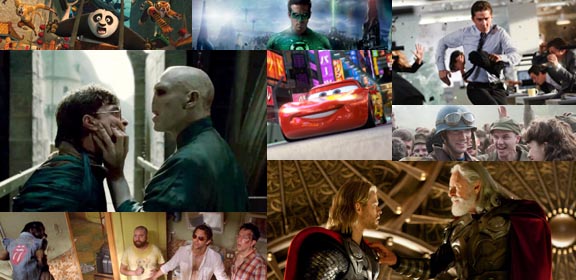These Summer 2011 Box Office Numbers Will Intrigue, Then Depress You
Oh Hollywood

The summer is when movie theaters are expected to see lots of seats filled with people hankering for a big, blowy-uppy blockbuster movie with characters they know doing things they’ve never seen before. Or maybe just more elaborate versions of things they might have done before. And people came to see some of these movies in 3D this year, and it resulted in higher revenue for theaters. But here’s the catch to that: since 3D tickets cost more, the higher revenues were not a result of people buying more tickets, it was just less people buying more expensive tickets. Because those “higher revenues” were higher by less than one percent. The summer of 2011 marked the worst summer for theaters since 1997, with the second lowest number of tickets sold in 14 years. Bummer.
Back in 1997, which is considered to be one of the most dire summers for tickets sales ever (despite releases like Men in Black, The Lost World: Jurassic Park, and G.I. Jane … oh yeah, it was that summer), only 540 million tickets were sold, the worst number seen at that point in these modern, moviegoing times. This summer, 543 million tickets were sold, marking four years in a row of shrinking movie attendance.
So, what’s going on here? /Film cites a “continued erosion of the theater experience,” and combined with movies that either don’t pique the audience’s interest (Cowboys and Aliens, sadface) or movies with bad word-of-mouth (Green Lantern), why would people spend increasing amounts of money to come to the theater? Because the “theater experience” doesn’t just include the tickets, but also the stupidly expensive food, a major source of income for theaters. To say nothing of the people who spill their $6 gallon of soda on the floor for all of us to step in … I know, I know: “Get off my lawn!”
Theaters try to satiate audiences (or distract them) by offering growing amounts of movies on IMAX screens or in 3D (18 movies were released in 3D this summer), but sometimes, people just aren’t interested. Personally, I was not thrilled that I had to pay about $17 to see Fright Night in 3D, as much as I liked it. But I could not find a good showtime for a regular version of the movie, so I had to spend the $17 on a movie that really, really, really didn’t have to be in 3D. I’m sure I’m not the only member of the moviegoing public who kind of resented having this decision made for me, or making the assumption that I require gimmicky fads to see a vampire horror comedy whose virtue lies in the script and performances and not the odd drop of blood that OMG LOOKS SO CLOSE TO ME.
There is also an increasing dependance by studios on foreign ticket sales, relying on the money that will be made internationally, which is what put Harry Potter and the Deathly Hallows: Part 2 over $1 billion. The New York Times says that even movies that were either not well-received here, such as Cars 2 and Pirates of the Caribbean 4: On Stranger Tides, were huge successes in China and Russia:
“Stranger Tides,” for example, took in almost $70 million less in North America than its 2007 predecessor, “Pirates of the Caribbean: At World’s End.” But “Stranger Tides” took in $145 million more than “At World’s End” overseas.
There is good news coming out of all this dreck, though: R-rated comedies (that had good buzz) did well. One of these major successes was Bridesmaids, which made $281 million worldwide. That’s a big deal, considering the movie was made for $33 million and was taking a huge risk as a female-driven, R-rated comedy that was not romantic comedy tripe. Hangover II also did extremely well, along with Bad Teacher, Horrible Bosses, and the Woody Allen sleeper hit Midnight in Paris (which made $53 million). (But not The Change-Up.)
But here is the bottom line:
After the first quarter [of 2011], ticket sales were down a staggering 20 percent compared with the same period in 2010. Sales lag 4 percent for the year.
Looking at these numbers is depressing, to say the least, but also kind of weird. On one hand, movies that were almost designed to be big, huge, stupid movies made tons of money. See: Transformers: Dark of the Moon. On the other hand, movies that were almost designed to be big, huge stupid movies … ended up being exactly that. See: Green Lantern. Lots of people saw good movies (Harry Potter) and lots of people saw bad movies (Pirates 4). But lots of people didn’t see good movies (Cowboys and Aliens) and lots of people didn’t see bad movies (Zookeeper). What do we take away from this? American moviegoers are actually hard to please. Sometimes. But it also looks like some of them have given up on going to the movies altogether.
(The New York Times via /Film)
Have a tip we should know? tips@themarysue.com